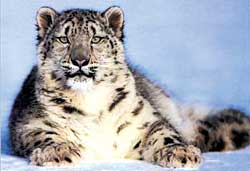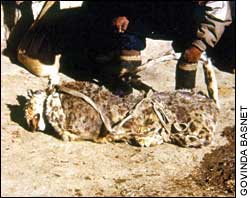 The day hundreds of years ago, it is said, that a tribal hunter called Keragomba Dorje was hunting in an alpine meadow in the Himalaya. The hunter, chasing a wild blue sheep, came upon Milerapa deep in meditation. Before the hunter could kill his prey, the thoughtful Lama persuaded him not to do so. That day, a hunter turned conservationist. Today in Manang's Nyeshang valley is a cave known after Milarepa's disciple. The lessons of Milarepa have stayed in Manang valley, where nature is still considered the abode of the spirit world and where all animals are divine.
The day hundreds of years ago, it is said, that a tribal hunter called Keragomba Dorje was hunting in an alpine meadow in the Himalaya. The hunter, chasing a wild blue sheep, came upon Milerapa deep in meditation. Before the hunter could kill his prey, the thoughtful Lama persuaded him not to do so. That day, a hunter turned conservationist. Today in Manang's Nyeshang valley is a cave known after Milarepa's disciple. The lessons of Milarepa have stayed in Manang valley, where nature is still considered the abode of the spirit world and where all animals are divine. This, at least, is what I figured out after working in the rain-shadow valley for four years with the King Mahendra Trust for Nature Conservation's (KMTNC) Annapurna Conservation Area Project (ACAP) in the early nineties. But I also learnt about how, occasionally, snow leopards are killed by hired shepherds mostly from adjacent districts, in retribution for the animals having attacked the villagers' sheep, goats and expensive horses. In conservation ecology this is called "culling", and it stopped being allowed in 1993, when ACAP set up office in the district. Although it is acknowledged that a snow leopard attacks the livestock only when its natural prey are hard to find, and that to protect the snow leopard means its habitat and neighbours all need to be protected too, the story in Manang Valley is a bit different.

In Manang, the chances of a snow leopard encountering livestock, rather than its natural prey, blue sheep, are far higher. Manang Valley supports large populations of blue sheep-up to eight per sq km-but the number of livestock is equally high, and the biomass of yaks is almost three times as high as that of blue sheep. In addition, because of the influence of tourism and changing lifestyle patterns, the number of sheep and goats being bred has increased; these animals are far more vulnerable to snow leopard attack than yaks.
There are currently 300-500 snow leopards-about one-tenth of the world's snow leopard population-in the 2,200 km sq Nepal's eight national parks, conservation areas and hunting reserves cover. And since 1973, snow leopards have been protected internationally by the Convention on International Trade in Endangered Species of Wild Fauna and Flora (CITES) and in Nepal under the National Park and Wildlife Conservation (NPWC) Act.
But, since the inhabitants of Manang depend on animal herding for their livelihood, they've been petitioning ACAP for close to a decade now to allow the culling of problematic snow leopards to continue. Now for ACAP, or rather, the King Mahendra Trust, to allow this, it must first get approval from the government, but none of Nepal's conservation laws address the possibility of culling endangered species, no matter how much damage they cause. And thus the stalemate continues, and instead of conservation professionals understanding more about the snow leopard, Manang and figuring out possible alternatives to this practice, they seem to know even less than they did before. Just a couple of months ago, a colleague of mine rushed into my office to break the 'news' that some 20-22 snow leopards had been killed in Manang. The rumour, he told me, was all over our small conservation community. I was perplexed and shocked by the news, not because so many snow leopards met their maker, but because of the naivet? of Nepali conservationists and managers. A quarter of a century after snow leopards in Nepal were first radio-tagged and efforts were started to know more about this secretive cat, they still did not know something very basic: that such massacre needed either a massive poisoning campaign or shooting from the air, the tools and techniques for neither of which could conceivably work in a place like Manang. For another, less than 15 snow leopards may roam in the entire Upper Manang valley. After all, it is just about 600 km sq, and only a third of it is suited to habitation by the endangered cats, ecologically speaking.
 The effort required to intentionally hunt a snow leopard in such a wild, desolate land is enormous, even for the local hunters who are now anyway almost non-existent in Manang. Moreover, in places like Manang, strong religious sentiments are against such mass killing, particularly given the snow leopard's legendary place in local folklore. Mananges believe that snow leopards (and domestic cats) are born to remove the sins of past lives; killing these animals means having their sins transferred to your own life. Another folktale describes the snow leopard as a 'fence' for crops, meaning that in the absence of snow leopards livestock would be free ranging and invade crop fields. So, folk wisdom, metaphorically, suggests that the presence of the snow leopard is an indicator of a decent livelihood. Even without any of this, ACAP has conducted hundreds of mobile conservation camps, household visits, street theatres and special classes at schools to create widespread awareness that it is illegal to kill snow leopards.
The effort required to intentionally hunt a snow leopard in such a wild, desolate land is enormous, even for the local hunters who are now anyway almost non-existent in Manang. Moreover, in places like Manang, strong religious sentiments are against such mass killing, particularly given the snow leopard's legendary place in local folklore. Mananges believe that snow leopards (and domestic cats) are born to remove the sins of past lives; killing these animals means having their sins transferred to your own life. Another folktale describes the snow leopard as a 'fence' for crops, meaning that in the absence of snow leopards livestock would be free ranging and invade crop fields. So, folk wisdom, metaphorically, suggests that the presence of the snow leopard is an indicator of a decent livelihood. Even without any of this, ACAP has conducted hundreds of mobile conservation camps, household visits, street theatres and special classes at schools to create widespread awareness that it is illegal to kill snow leopards. One of the reasons such a baseless rumour takes root is that conservation agencies in this country tend to be somewhat oblivious to the work that their fellow workers and agencies are doing. This is in evidence even in His Majesty's Government, which does not recognise that the Annapurna Conservation Area has the same value for conservation as a national park. Annapurna, Nepal's largest protected area, is missing from the list, even though the project was one of the first that linked ecology and the economy in what has since become an internationally recognised conservation model. Also, since 2000, the King Mahendra Trust has initiated a $2.1 million biodiversity project in Upper Mustang with support from major donors. This is the most expensive undertaking in the history of conservation in Nepal devoted to the cause of the snow leopard. The effort to conserve the snow leopard simultaneously in Mustang and adjoining Manang.
With all these efforts, the truth about something like this snow leopard rumour would be easy to find out, and the whole process of conservation, and reducing the conflict between humans and animals would be significantly better informed, if not easier, if there were a well-coordinated central database for biodiversity, which is essential for the long-term management of the country's resources. In the absence of coordination and cooperation, any measures against environmental degradation tend to be short-term, because there simply isn't enough holistic information to go around. As for mistakes, it just becomes easier to hide them and longer to find out.
There's another hot rumour now: the Nepal Country Action Plan, that is being drafted for the snow leopard. It is typically ironic that I did not hear about it formally in Nepal but at the recent Snow Leopard Survival Summit in Seattle in May, where I represented Nepal on behalf of the King Mahendra Trust. So, we have a management action plan. Now comes the simple matter of making sure the right hand knows what the left is doing. Snow leopards have a difficult enough time in very tough terrain. To do anything for them, we're going to need to be organised.
(Som B Ale is on the permanent staff of the KMTNC. He is currently pursuing a PhD in Biological Sciences at the University of Illinois in Chicago.)


